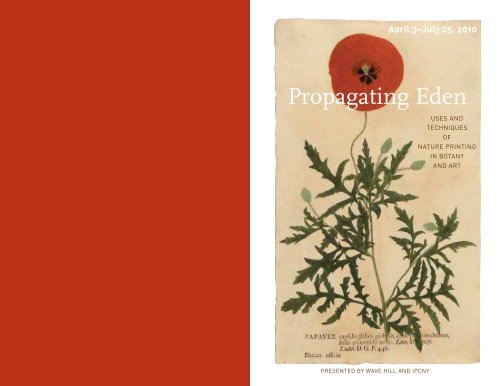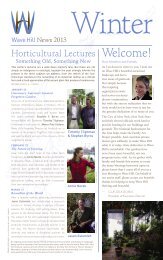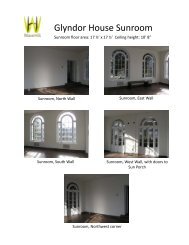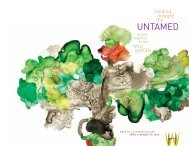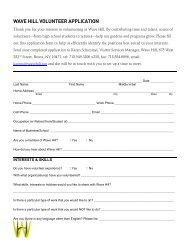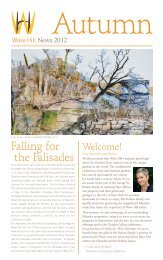Propagating Eden - Wave Hill
Propagating Eden - Wave Hill
Propagating Eden - Wave Hill
Create successful ePaper yourself
Turn your PDF publications into a flip-book with our unique Google optimized e-Paper software.
<strong>Propagating</strong> <strong>Eden</strong><br />
PresenTed By <strong>Wave</strong> hill and iPcny<br />
April 3–July 25, 2010<br />
Uses and<br />
TechniqUes<br />
of<br />
naTUre PrinTing<br />
in BoTany<br />
and arT
PresenTed By<br />
<strong>Wave</strong> hill<br />
and<br />
iPcny<br />
ProPagating EdEn is supported by the NatioNal<br />
eNdowmeNt for the arts, the reed fouNdatioN aNd<br />
the arthur ross fouNdatioN. support for wave hill’s<br />
visual arts program is provided by the lily auchiNcloss<br />
fouNdatioN, iNc., miltoN & sally avery arts<br />
fouNdatioN, the greeNwall fouNdatioN, aNd the New<br />
york state couNcil oN the arts–a state ageNcy.<br />
AnnA Atkins<br />
Alois Auer<br />
MiroslAv BAlkA<br />
BrAndon BAllenGée<br />
AuGustin BAlleydier<br />
WilliAM Henry BrAdBury<br />
susAn derGes<br />
MicHele okA doner<br />
MAx ernst<br />
constAntin von ettinGsHAusen<br />
and Alois Pokorny<br />
BenJAMin FrAnklin<br />
AdAM Fuss<br />
AnA Golici<br />
vAlerie HAMMond<br />
FrAncis GeorGe HeAtH<br />
JoHAnn Julius Hecker<br />
BertHA JAques<br />
JoHAnn HieronyMus kniPHoF<br />
ricHArd lonG<br />
AdAM loWe<br />
cHristiAno GottlieB ludWiG<br />
MArisol<br />
André MAsson<br />
GABriel orozco<br />
J. e. PArritt<br />
GiusePPe Penone<br />
cArlo And AGostino Perrini<br />
dAn Peyton<br />
MAn rAy<br />
ed ruscHA<br />
JosePH scHeer<br />
Henry sMitH<br />
kiki sMitH<br />
WilliAM Henry Fox tAlBot<br />
kAte teMPle<br />
<strong>Propagating</strong> <strong>Eden</strong><br />
Uses and<br />
TechniqUes<br />
of<br />
naTUre PrinTing<br />
in BoTany<br />
and arT<br />
April 3–July 25, 2010<br />
<strong>Wave</strong> <strong>Hill</strong> Glyndor Gallery<br />
organized By<br />
inTernaTional PrinT cenTer<br />
neW york (iPcny)<br />
cUraTed By<br />
Pari sTave & MaTTheW zUcker
With <strong>Propagating</strong> <strong>Eden</strong>: Techniques of Nature Printing in Botany and Art, International<br />
Print Center New York (IPCNY) pays homage to the beauty of natural plant forms,<br />
pure and unadulterated, captured by artists and botanists past and present. Originally<br />
presented in our Chelsea gallery, the exhibition advances IPCNY’s mission to nurture<br />
the appreciation of fine art prints in their many manifestations, ranging in technique<br />
from classic to experimental, and illustrated in the superb selection of prints shown<br />
here.<br />
<strong>Propagating</strong> <strong>Eden</strong> represents one of the more than fifty exhibitions organized by<br />
IPCNY to date, and the first devoted to a particular genre of printmaking. We are<br />
delighted to share it through our Exhibitions Touring Program with other institutions<br />
and their constituencies (for further information, visit www.ipcny.org).<br />
This presentation is made possible with generous grants to IPCNY from The<br />
Reed Foundation and the Arthur Ross Foundation. We extend thanks also to the<br />
co-curators of the exhibition, Pari Stave and Matthew Zucker, to Jennifer McGregor,<br />
and to the lenders whose commitment to sharing their collections and advancing<br />
scholarship is deeply appreciated.<br />
Anne Coffin<br />
Director<br />
International Print Center New York<br />
2<br />
JoHAnn HieronyMus kniPHoF<br />
Botanici in Originali Seu Herbarium Vivum,<br />
<strong>Propagating</strong> <strong>Eden</strong> introduces nature printing, a technique that furthered botanical<br />
understanding and continues to be developed by contemporary artists as a way to<br />
connect with nature. This is of special interest at a time when people are reevaluating<br />
their own relationship to the natural world. We are especially pleased to offer visitors<br />
the opportunity to experience the art shown in our galleries in relation to the artistry<br />
of our gardens. Toward this end, gallery tours will be offered on Tuesdays and Thursdays<br />
at noon, and Saturdays at 2 pm. On May 23 at 2 pm we are hosting a lively discussion<br />
moderated by Pari Stave about the history of nature printing and its allure for<br />
contemporary artists with Michele Oka Doner, artist; Patricia Jonas, director of the<br />
Brooklyn Botanic Garden’s Library Services and curator of the Florilegium Society;<br />
and Karen Reeds, scholar.<br />
Co-curators Pari Stave and Matthew Zucker deserve our grateful thanks for conceiving<br />
of this unusual exhibition and searching for examples of this little-known form of<br />
printing. Thank you to the National Endowment for the Arts who awarded <strong>Wave</strong><br />
<strong>Hill</strong> a grant to work with IPCNY on this exhibition. We are grateful to Anne Coffin<br />
and her staff, Kendra Sullivan and Amanda Young, for organizing this exhibition,<br />
which expands the scope of <strong>Wave</strong> <strong>Hill</strong>’s Visual Arts Program. My staff, Leigh Ross,<br />
assistant curator, and Stephanie Lindquist, arts program fellow, produced excellent<br />
label copy, guided by Pari Stave, and by Roderick Cave’s forthcoming book Impressions<br />
of Nature: A History of Nature Printing, which has been very helpful to all of us in<br />
understanding the development and applications of nature printing throughout time.<br />
Thank you to the artists who lent<br />
their work to the exhibition as well<br />
as Timothy Baum, New York, NY;<br />
Ruby Beets, Sag Harbor, NY; The<br />
Buhl Collection, New York, NY;<br />
Edition Jacob Samuel, Santa Monica,<br />
CA; GV Art, London, UK; Donald<br />
Heald, New York, NY; Paul Kasmin<br />
Gallery, New York, NY; Hans P. Kraus,<br />
Jr., New York, NY; Mixografia®, Los<br />
Angeles, CA; Anthony E. Nicholas,<br />
The Lapis Press, Culver City, CA;<br />
Julie Saul Gallery, New York, NY; Kiki<br />
Smith, New York, NY; The Universal<br />
Limited Art Editions, Inc., Bay Shore,<br />
NY; Wildwood Press, LLC, St. Louis,<br />
MO; and to private collections.<br />
Jennifer MCGreGor<br />
Director of Arts & Senior Curator<br />
<strong>Wave</strong> <strong>Hill</strong><br />
3
<strong>Propagating</strong> <strong>Eden</strong>:<br />
Uses and Techniques of<br />
Nature Printing in Botany and Art<br />
Nature printing is a name given to the technique of taking impressions from the<br />
surface of an organic form, such as a leaf, flower, feather, skin, shell, bone, or<br />
mineral. The process is suggested by nature herself, in fossil remains, some dating<br />
back through millions of years, revealing scientific evidence of the origins of life<br />
and clues to the myriad pathways of evolution.<br />
The human impetus to create self-prints can be as simple as a child’s finger<br />
painting, and as poignant and poetic an assertion of one’s presence in the world as<br />
the stenciled, silhouetted outlines of human hands found in prehistoric cave paintings—both<br />
gestures seeming to declare: “I was here.” Indeed, the trace left behind in<br />
the self-image can also incriminate, as fingerprinting, too, is a form of nature printing,<br />
establishing unequivocally the unique identity of the self.<br />
<strong>Propagating</strong> <strong>Eden</strong> is concerned with nature printing as an illustrative tool used in<br />
the service of science, numismatics, and self-expression. The exhibition examines<br />
closely the process by which “faithful” reproductions from natural forms are printed,<br />
4<br />
FrAncis GeorGe HeAtH<br />
I. Hard Prickly Shield Fern<br />
by what technical means<br />
and to what ends. Giving<br />
more or less equal weight to<br />
images created for disparate<br />
purposes, the works shown<br />
here embody developments<br />
in nature printing techniques<br />
from the mid-eighteenth century<br />
to the present—a period<br />
of momentous advancement<br />
in scientific knowledge and<br />
the technology of image<br />
reproduction, as well as of<br />
radical shifts in the role of<br />
nature as subject, muse,<br />
and collaborator in art.<br />
That the exhibition<br />
comprises mostly botanical<br />
subjects is a function of a<br />
practical reality: The shallow<br />
depth of plant material—of<br />
leaves in particular—lends<br />
itself well to planar printing,<br />
WilliAM Henry BrAdBury<br />
Bree’s Fern<br />
which explains the importance<br />
of nature printing to<br />
the history of botany in particular. Nature printing can be seen as a subset of the<br />
larger history of botanical illustration—a largely Western tradition dating back to<br />
late classical antiquity, founded on the precondition that plants should be rendered<br />
recognizable enough as to clearly distinguish one from another—an important, if not<br />
critical consideration where plant-based foods and medicines are concerned. There<br />
is also an enthobotanical factor at play here, underscoring the complex relationship<br />
between humans and their use of plants for sustenance, healing, currency, taxonomy,<br />
symbolism, and design, and the importance imagery plays in conveying information.<br />
The exhibition is not a historic survey. The juxtaposition of nature prints produced<br />
across disciplines—either for highly specific botanical description (the scientific<br />
illustrations being decontextualized from their descriptive function and activated as<br />
art objects) or incorporating natural forms for expressive effect—is intended to invite<br />
us to find common ground among modes of representing objective reality, the invention<br />
and mastery of various printing techniques, and the imposition—intentional or<br />
not—of formal, aesthetic considerations.<br />
PAri StAve<br />
Co-Curator<br />
5
AnnA Atkins<br />
Trichomanis crinitum (Jamaica), circa 1851–54<br />
Cyanotype negative<br />
10 x 8 inches<br />
Courtesy of Hans T. Kraus, Jr., New York, NY<br />
Anna Atkins (1799–1871) was the first to publish a book of scientific illustrations<br />
using the cyanotype process. Her publication, British Algae: Cyanotype Impressions,<br />
was produced entirely by photographic means, and she is thought by some to have<br />
been history’s first female photographer. Atkins was educated in the fields of botany,<br />
taxonomy, and scientific illustration. Her father, Sir George Children, was a renowned<br />
scientist whose circle of friends included William Henry Fox Talbot.<br />
Atkins’s scientific interests encouraged her to explore the use of cyanotype for<br />
the purposes of taxonomy. She published a total of three volumes of British Algae:<br />
Cyanotype Impressions between 1843 and 1853, presenting exquisite illustrations of the<br />
plant life found in the sea. The print shown here exemplifies the brilliant blue color<br />
and compositional arrangement of Atkins’s prints, as well as their scientific value.<br />
Only seventeen copies of the book are known to exist.<br />
6<br />
Alois Auer<br />
Moss Specimen<br />
From Ludwig Ritter von Heufler, Eine<br />
Probe der Kryptogamischen Flora des<br />
Arspachtales in den Siebenburgischen,<br />
1853<br />
Published by K. K. Hofund<br />
Staatsdruckerei, Vienna, Austria<br />
21 x 14 inches<br />
Private collection<br />
This delicate image was printed<br />
under the direction of Alois Auer<br />
(1813–1869), the director of<br />
kaiserlich-königlich Hof-und<br />
Staatsdruckerei, the Austrian<br />
national printing office in Vienna.<br />
Auer transformed the Staatsdruckerei<br />
into a model printing house with the most modern equipment and gifted craftsmen<br />
from all over the continent. During the Great Exhibition of London in 1851, the<br />
Staatsdruckerei was awarded two medals for its work in galvanoplasty, an indirect<br />
form of printing that relies on electroplating, which strengthens molds of soft objects<br />
by electrolytically plating them with metal, and chemitype, another indirect form<br />
of printing invented by C. Pill, which turns an intaglio plate into a relief block.<br />
Around 1853, Auer’s overseer, Andreas Worring, invented a new technique<br />
whereby the most nuanced prints could be made from rolling specimens between<br />
plates of polished lead and steel, embedding the object into the lead. Auer named this<br />
technique Naturselbstdruck or “Nature self-printing process.” He found the technique<br />
to be so valuable that he refused to patent it so that it could be freely used. The image<br />
on view was made using this innovative technique.<br />
7
8<br />
AnonyMous<br />
Lotus<br />
From Leaf Prints. India, circa 1850<br />
103 unnumbered sheets of nature-printed leaves, stems, and thorns, many plants<br />
indigenous to India, with Tamil names written in pencil on the bottom of the plates<br />
Folio: 16 ¾ x 11 inches<br />
Private collection<br />
9
AuGustin BAlleydier<br />
Polypus, 1956<br />
From Album Jacquard<br />
Paris<br />
Lithographs printed in color after nature printing<br />
Private collection<br />
10<br />
WilliAM Henry BrAdBury<br />
Three-nerved Sandwort<br />
Tormentil<br />
From Thomas Moore and John Lindley, The Ferns of Great Britain and Ireland, 1855—57<br />
Hand-colored intaglio print from an electrotyped soft lead plate<br />
Printed and published by Bradbury & Evans, London<br />
21 3/8 x 14 3/8 inches each<br />
Private collection<br />
Henry Bradbury (1831–1860) self-published The Ferns of Great Britain and Ireland when<br />
he was twenty-four at the peak of the Victorian fern craze. Its text was written by<br />
Thomas Moore, curator of the Chelsea Physic Garden. The folio consisted of fifty-one<br />
plates and cost an extraordinary six guineas. Despite the similarities between Alois<br />
Auer’s and Bradbury’s methods, Bradbury’s technique often caused distortions,<br />
crushing fleshy stems under too much pressure. His prints were also criticized for<br />
their translucent coloring, which appears artificial. Bradbury & Evans later published<br />
The Nature-Printed British Seaweeds (1858–60) and The Octavo Nature-Printed Ferns<br />
(1859–60). After Bradbury’s unexpected suicide, no one else is known to have used<br />
this process in Great Britain.<br />
11
MicHele okA doner<br />
Untitled (Lungs), 2007<br />
Relief on handmade paper (unique)<br />
Printed and published by Wildwood Press, LLC, St. Louis, MO<br />
44 x 44 inches<br />
Courtesy of the artist and Wildwood Press, LLC, St. Louis, MO<br />
Untitled (Lungs) belongs to a series of unique prints by internationally acclaimed artist<br />
Michele Oka Doner (b. 1945). As part of her practice, Oka Doner frequently gathers<br />
natural specimens along the Miami shore. For this series, she uses roots of the endangered<br />
banyan tree that she found. Like German printer Johann Hieronymus Kniphof,<br />
she directly inks her specimens and prints them onto paper using a press. In addition<br />
to the taxonomical significance the series reacquaints the viewer to his primal relation<br />
to nature.<br />
12<br />
BenJAMin FrAnklin<br />
Full sheet of nature printed American currency, 1779<br />
Hall & Sellers, Philadelphia<br />
Printed on front and back, showing eight uncut notes on one sheet<br />
7 ¼ x 11 ¼ inches<br />
Private collection<br />
One of the Founding Fathers of the United States, Benjamin Franklin (1706–1790)<br />
was a man of many titles: statesman, inventor, diplomat, author, and, significantly,<br />
an accomplished printer. Inspired by his colleague Joseph Brietnal’s experiments with<br />
nature printing, Franklin was the first person to incorporate the impressions of leaves<br />
onto printed currency.<br />
Franklin was interested in the inimitable precision of nature printing, primarily as<br />
way to thwart the efforts of counterfeiters. Franklin’s methods were kept secret in<br />
order to preserve their effectiveness, but it seems likely that he first made a plaster<br />
impression of a leaf, adhering the leaf first to a piece of damp cloth and then layering<br />
more cloth over the top, so that the resulting negative cast incorporated both the<br />
delicate veins of the leaf and the unique texture of the cloth. When this cast had<br />
hardened, liquid type metal would be poured over it, revealing a highly detailed image<br />
that was difficult to copy.<br />
13
vAlerie HAMMond<br />
Jane, 2006<br />
Xerox transfer, pencil, and wax on paper<br />
Printed and published by the artist<br />
20 ½ x 16 ½ inches<br />
Courtesy of Kiki Smith, New York, NY<br />
Traces 21 (Gabrielle), 2009<br />
Xerox transfer, pencil, and wax on paper<br />
Printed and published by the artist<br />
20 ½ x 16 ½ inches<br />
Courtesy of the artist<br />
Glimmer, 2009<br />
Xerox transfer, pencil, and wax on paper<br />
Printed and published by the artist<br />
72 x 36 inches<br />
Courtesy of the artist<br />
In Jane, Valerie Hammond (b. 1952) layers images of ferns onto a silhouette of her<br />
mother’s hand to make this mysterious portrait. Hammond draws her inspiration<br />
from enchanted objects throughout history. Here, she reflects her fascination with<br />
Victorian aesthetics and nature prints of ferns during the 1890s. Hammond uses<br />
xerography, a dry photocopying technique using electrostatic energy, to make the<br />
images of ferns before chemically transferring them onto paper. Developed in<br />
Astoria, NY, in 1938 by Chester Carlson, xerography is commonly used in<br />
photocopying machines and LED printers. Hammond also often adds watercolor<br />
images of nature and elements of Victorian craft, such as sewing and beadwork<br />
before submerging the image in wax—symbolically embalming it.<br />
14<br />
15
16<br />
JoHAnn Julius Hecker<br />
Centauria<br />
From Flora berolinensis, 1757–58<br />
Realschulbuchhandlung, Berlin<br />
14 3/4 x 8 3/4 inches each<br />
Private collection<br />
17
JoHAnn HieronyMus kniPHoF<br />
Botanici in Originali Seu Herbarium Vivum, 1757–64<br />
Folio of direct nature prints with hand coloring<br />
12 7/8 x 7 13/16 inches each, loose sheets<br />
Private collection<br />
Botanici in Originali Seu Herbarium Vivum, 1757–64<br />
Folio of direct nature prints with hand coloring<br />
14 5/16 x 9 1/8 inches, bound volume<br />
Private collection<br />
Some of the earliest works shown in <strong>Propagating</strong> <strong>Eden</strong> are these flowers, printed<br />
directly from flattened and dried specimens by Johann Hieronymus Kniphof<br />
(1707–1763). Each specimen was pressed carefully onto a black inked surface,<br />
pressed onto paper, and subsequently hand colored. Over two centuries old,<br />
Kniphof’s colored prints remain quite beautiful and botanically accurate except<br />
for when the ink is too opaque and hides the plant’s skeletal lines.<br />
18<br />
Kniphof, a German professor at Erfurt University, doctor, and keeper of the city’s<br />
botanic garden, was first attracted to nature printing due to its economic advantages<br />
over other processes of illustrating botanical books, such as woodcuts or copperplates.<br />
He worked with bookseller Johann Michael Funcke to develop this technique to<br />
produce illustrated books, individual prints, and even prints made to order. This<br />
technique of nature printing was especially grueling given that no specimen could<br />
be inked more than five times. Funcke issued two herbals with Kniphof that included<br />
well over one hundred prints, with their more expensive versions including colored<br />
prints. Each print has a woodcut label indicating the print’s number and the plant’s<br />
German name.<br />
19
icHArd lonG<br />
Mud Hand Prints, 1984<br />
Artists book. Edition of 100<br />
Coracle Press, 233-235 Camberwell, New Road, London SES<br />
13 ½ x 11 ½ x 7/16 inches<br />
Courtesy of Anthony E. Nicholas, The Lapis Press, Culver City, CA<br />
20<br />
21
22<br />
cHristiAno GottlieB ludWiG<br />
Belladonna<br />
From Ectypa Vegetabilium, 1760<br />
D. Christiano Gottlieb Ludwig, Leipzig<br />
14 13/16 x 9 inches<br />
Private collection<br />
23
24<br />
MArisol<br />
Catalpa Maiden About to Touch Herself, 1973<br />
Lithograph. Edition of 24<br />
Composition (irreg.): 40 1/16 x 27 5/8 inches<br />
Courtesy of Universal Limited Art Editions, Inc., Bay Shore, NY<br />
GABriel orozco<br />
Lotus Leaf, 2004<br />
Soft-ground etching, mounted between UV-resistant Plexiglas<br />
Published by The Lapis Press<br />
25 ½ x 28 5/8 x 5 3/8<br />
Courtesy of Anthony E. Nicholas, The Lapis Press, Culver City, CA<br />
25
J. e. PArritt<br />
Imprints from Nature, 1879<br />
Manuscript containing 87 unique prints made from plant leaves and nine poems<br />
Private collection<br />
26<br />
GiusePPe Penone<br />
L’image du Toucher, 1994<br />
Book<br />
12 x 9 ½ inches<br />
Private collection<br />
27
28<br />
cArlo And AGostino Perrini<br />
Adonis aestivalis<br />
Achilla atrata<br />
Anemone varnalis<br />
Convallaria multiflora<br />
From Flora dell’Italia settentrionale (e del Tirolo meridionale), 1854–65<br />
Tipografia Perini, Trento<br />
A collection of nature-printing plates color printed in relief with added hand coloring<br />
16 ¼ x 11 ¼ inches each<br />
Private collection<br />
dAn Peyton<br />
Spring Tree, 2006<br />
Cyanotype solargram (unique)<br />
34 x 55 inches<br />
Courtesy of the artist and GV Art, London, UK<br />
29
ed ruscHA<br />
Clock, 1994<br />
Mixografia® print on handmade paper. Edition of 75<br />
Published by Mixografia®, Los Angeles, CA<br />
40 ½ x 34 inches<br />
Courtesy of the artist and Mixografia®, Los Angeles, CA<br />
photo: Scott Lindgren Photography<br />
30<br />
JosePH scHeer<br />
Coloradia Pandora davisi, 2007<br />
Iris print<br />
34 x 46 inches<br />
Courtesy of Ruby Beets, Sag Harbor, NY<br />
31
32<br />
Henry sMitH<br />
Mangifera indica<br />
From Specimens of Nature Printing from Unprepared Plants, 1857<br />
Printed and published by H. Smith at the Fort Saint George Gazette Press, Madras<br />
20 1/8 x 13 13/16 inches<br />
Private collection<br />
33
kiki sMitH<br />
Moment, 2006<br />
Lithograph with watercolor and pressed leaves. Varied edition<br />
Published by Universal Limited Art Editions, Inc., Bay Shore, NY<br />
22 x 30 inches<br />
Courtesy of Universal Limited Art Editions, Inc., Bay Shore, NY<br />
34<br />
WilliAM Henry Fox tAlBot<br />
Truncated Fern, 1858<br />
Photoglyphic engraving<br />
5 3/8 x 6 5/16 inches<br />
Courtesy of Hans P. Kraus, Jr., New York , NY<br />
William Henry Fox Talbot (1800–1877) was the inventor of the calotype process and<br />
an early developer of photomechanical reproduction. In inventing the calotype, Talbot<br />
was the first individual to fix impressions onto light-sensitized paper, a process he<br />
called “photogenic drawing.” Talbot also developed a process for reproducing photographic<br />
images with printer’s ink, a precursor to photogravure, called “photoglyphic<br />
engraving.”<br />
Talbot’s nature prints of plant specimens are among the most striking of these rare<br />
and fragile works because he achieved a high-contrast and finely detailed result. The<br />
delicacy of the calotype was in fact its most challenging aspect, and calotype prints<br />
were reputed to fade dramatically almost immediately after exposure. In an attempt<br />
to circumvent this issue, Talbot developed and patented a new intaglio process that<br />
he called “photoglyphic engraving,” a form of photography that could make plates<br />
to be printed with the standard trade methods of the time. This process reflects the<br />
earlier work of Talbot’s colleagues, such as Sir John Herschel, and influenced the photography<br />
of Anna Atkins, whom he instructed directly on the calotype process.<br />
35
36<br />
kAte teMPle<br />
earth/pool # 3, 2006<br />
Aquatint with drawing on rice paper, mounted on canvas (unique)<br />
Printed and published by the artist<br />
24 x 24 inches<br />
Courtesy of the artist<br />
“If nitric acid could eat away at a plate in thirty minutes, I asked myself what would<br />
happen if the plate were exposed to nature.” –KAte teMPle<br />
In 2001, contemporary artist Kate Temple (b. 1966) investigated this question by<br />
burying a zinc plate covered with aquatint (a fine powder resin evenly melted onto<br />
the plate) into a vernal pond. For twelve months nitrogen from decaying maple, oak<br />
and beech tree leaves etched the plate’s surface. After the original impression was run<br />
through the press, she continued to print layers of translucent ink in order to suggest<br />
the surface of a pond. Unique among this exhibit’s printers, Temple ’s work reveals a<br />
sense of time cycling.<br />
37
Additional Work<br />
MiroslAv BAlkA<br />
Entering Paradise, 2003<br />
Copperplate etching (from a portfolio of 13 impressions,<br />
12 of the feet of homeless men, and 1 of an orange peel)<br />
15 ¾ x 15 inches<br />
Courtesy of Edition Jacob Samuel, Santa Monica, CA<br />
BrAndon BAllenGée<br />
Early Life Series, 2001<br />
Iris print on watercolor paper. Edition of 3<br />
46 ½ x 34 5/8 inches<br />
High-resolution scanner photography conducted in 2000/2001<br />
Courtesy of the Rockefeller Foundation (E-STAR Grant) Institute for<br />
Electronic Arts, School of Art and Design, New York State College of<br />
Ceramics at Alfred University, Alfred, NY<br />
susAn derGes<br />
Full Moon – Holly, 2003<br />
Photogram (unique Ilfachrome print)<br />
68 ¾ x 27 ¼ inches<br />
Courtesy of Paul Kasmin Gallery, New York, NY<br />
MAx ernst<br />
Les moeurs des feuilles (The Habitat of Leaves)<br />
From Histoire Naturelle, 1926<br />
Portfolio of 34 collotypes after frottage<br />
Introduction by Jean Hans Arp, 1926. Frottages executed circa 1925<br />
Galerie Jeanne Bucher, Paris, France<br />
Courtesy of Timothy Baum, New York, NY<br />
constAntin von ettinGsHAusen and Alois Pokorny<br />
Fritillaria Meleagris<br />
From Physiotypia Plantarum Austriacarum, 1854–56<br />
25 x 20 inches<br />
Courtesy of Donald Heald, New York, NY<br />
AdAM Fuss<br />
Untitled (sunflower) 1, 1993<br />
Photogram (unique Cibachrome print)<br />
22 x 18 x ¾ inches<br />
Courtesy of The Buhl Collection, New York, NY<br />
38<br />
AnA Golici<br />
Weeds I, 2002<br />
Laserjet print on silk<br />
Printed and published by the artist<br />
11 x 8 ½ inches<br />
Courtesy of the artist<br />
FrAncis GeorGe HeAtH<br />
I. Hard Prickly Shield Fern<br />
From The Fern Paradise, 4th Edition, 1878<br />
12 plates, including 4 paste-in Woodburytypes<br />
Private collection<br />
BertHA JAques<br />
Sunset Fern, 1921<br />
Cyanotype<br />
15 ¾ x 8 ½ inches<br />
Courtesy of Julie Saul Gallery, New York, NY<br />
AdAM loWe<br />
Littoral Deposits, 1994<br />
Soft-ground etching<br />
Courtesy of the artist<br />
André MAsson<br />
Signes, 1942<br />
Soft-ground etching and aquatint. Edition of 30, trial proof<br />
Published by Kurt Valentin<br />
9 5/16 x 8 1/6 inches<br />
Courtesy of Timothy Baum, New York, NY<br />
MAn rAy<br />
Untitled, 1933<br />
Rayogram<br />
12 x 8 ½ inches<br />
Courtesy of Timothy Baum, New York, NY<br />
Catalogue entries for Alois Auer, Miroslav Balka, William Henry Bradbury,<br />
Michele Oka Doner, Valerie Hammond, Johann Hieronymus Kniphof,<br />
Kate Temple by Stephanie Lindquist; and for Anna Atkins, Benjamin Franklin,<br />
William Henry Fox Talbot by Leigh Ross.<br />
39
526 West 26th Street, #824<br />
New York, NY 10001<br />
212.989.5090<br />
www.ipcny.org<br />
International Print Center New York<br />
is a non-profit institution founded to<br />
promote the greater appreciation and<br />
understanding of the fine art print<br />
worldwide. Through exhibitions and<br />
innovative programming, IPCNY<br />
fosters a climate for the enjoyment,<br />
examination and serious study of<br />
artists’ prints—from the old master<br />
to the contemporary. IPCNY offers its<br />
members a program of workshop and<br />
gallery visits, and has established an<br />
informational website and Information<br />
Desk available to the public at the<br />
gallery.<br />
Design: Melanie Roberts.Design<br />
40<br />
target Free days<br />
Target sponsors free Tuesday and Saturday<br />
morning admission to <strong>Wave</strong> <strong>Hill</strong>, providing public<br />
access to the arts in our community.<br />
675 West 252nd Street<br />
Bronx, NY 10471-2899<br />
718.549.3200<br />
www.wavehill.org<br />
<strong>Wave</strong> <strong>Hill</strong> is a 28-acre public garden<br />
and cultural center in the Bronx overlooking<br />
the Hudson River and Palisades.<br />
Its mission is to celebrate the artistry<br />
and legacy of its gardens and landscapes,<br />
to preserve its magnificent views, and<br />
to explore human connections to the<br />
natural world through programs in<br />
horticulture, education and the arts.


